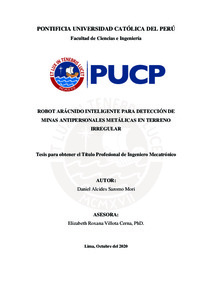| dc.contributor.advisor | Villota Cerna, Elizabeth Roxana | |
| dc.contributor.author | Saromo Mori, Daniel Alcides | |
| dc.date.accessioned | 2020-12-08T02:45:10Z | |
| dc.date.available | 2020-12-08T02:45:10Z | |
| dc.date.created | 2020 | |
| dc.date.issued | 2020-12-07 | |
| dc.identifier.uri | http://hdl.handle.net/20.500.12404/17649 | |
| dc.description.abstract | Debido a su bajo costo y a su simplicidad, enterrar minas antipersonales en el
campo de batalla ha sido, lastimosamente, una estrategia bélica muy común en el
siglo pasado. Sin embargo, la contaminación de tierras con minas antipersonales
es una problemática aún vigente en la actualidad, ya que más de sesenta países
siguen contaminados con estos explosivos. El desminado humanitario busca
erradicar todas las minas restantes en el mundo. Lamentablemente, el método
más utilizado actualmente para ejecutar labores de desminado es hacerlo de forma
manual, debido al elevado costo que representan los sistemas autónomos actuales.
Aunque existen propuestas de robots móviles que asisten estas labores, la mayoría
de ellas carece de versatilidad de desplazamiento sobre terreno irregular, ya que
utilizan ruedas para permitir el movimiento de estos sistemas.
En esta tesis, se propone el diseño de un robot arácnido para el traslado de un
sensor que permite la detección de minas antipersonales en terreno irregular.
En el ámbito mecánico, el robot tiene cuatro patas y presenta simetría sagital.
Los elementos electrónicos están alojados dentro del tórax, que se encuentra en el
centro del robot. El detector de minas se sujeta desde el tórax apuntando hacia
abajo. Se hizo el análisis dinámico del mecanismo las patas, con su respectiva
simulación cinemática y cinética. Además, se realizaron dos simulaciones de
esfuerzos en la estructura del robot mediante el método de elementos finitos.
Con respecto al diseño electrónico, se desarrollaron cálculos para los circuitos de
las fuentes de voltaje internas del robot. Se verificó la estabilidad de dichas fuentes
frente a ruidos eléctricos, ejecutando una simulación de los circuitos reguladores
de voltaje agregando ruido sinusoidal. Se realizó también la selección de los demás
componentes electrónicos del robot.
El ámbito de control es el aspecto más desarrollado de la presente tesis. Se plantea
un algoritmo innovador, que fusiona perspectivas de aprendizaje de máquina e
inteligencia artificial bioinspirada, para permitir que el robot aprenda a caminar.
De esta manera, se espera que el robot mejore su desempeño con el tiempo, a
medida que vaya obteniendo más experiencia y haya recolectado más datos de su
entorno. El algoritmo propuesto permite entrenar un agente inteligente para
maximizar una métrica de recompensa, pero sin aplicar técnicas de aprendizaje
por refuerzo, que son usualmente utilizadas en este tipo de problemas. | es_ES |
| dc.description.abstract | Due to its low cost and simplicity, burying anti-personnel landmines on the
battlefield has unfortunately been a ubiquitous war strategy in the last century.
However, land contamination with anti-personnel landmines is yet in force today
since more than sixty countries are still polluted with these explosives.
Humanitarian demining seeks to eradicate all remaining landmines worldwide.
Unfortunately, today's most widely used demining method is manual due to the
high cost of existing autonomous systems. Although there are proposals for mobile
robots that assist these tasks, most of them lack the versatility of movement on
uneven terrain since they use wheels for their locomotion.
In this thesis, an arachnid robot's design is proposed to carry a sensor that allows
the detection of anti-personnel landmines on uneven terrain.
In the mechanical domain, the robot has four legs and has sagittal symmetry. The
electronic components are housed within the thorax, which is located in the center
of the robot. The mine detector is held by the thorax, pointing downwards. A
dynamic analysis of the leg mechanism was made, with its respective kinematic
and kinetic simulation. Also, two stress simulations were made for the robot
structure using the finite element method (FEM).
Regarding the electronic design, calculations were performed for the circuits of
the robot's internal voltage sources. The stability of these sources against
electrical noise was verified. A simulation of the voltage regulator circuits' was
developed to check their response while adding sinusoidal noise. Additionally, the
selection of the other electronic components of the robot was made.
The control domain is the most developed aspect of this thesis. An innovative
algorithm is proposed, which merges machine learning and bio-inspired artificial
intelligence perspectives to allow the robot to learn to walk. In this way, the robot
improves its performance over time as it gains more experience and collects more
data from its environment. The proposed algorithm allows training an intelligent
agent to maximize a reward metric without applying reinforcement learning
techniques, which are usually the way to solve this type of problem. | es_ES |
| dc.language.iso | spa | es_ES |
| dc.publisher | Pontificia Universidad Católica del Perú | es_ES |
| dc.rights | info:eu-repo/semantics/openAccess | es_ES |
| dc.rights.uri | http://creativecommons.org/licenses/by-nc-sa/2.5/pe/ | * |
| dc.subject | Robots--Diseño y construcción | es_ES |
| dc.subject | Detectores | es_ES |
| dc.subject | Sensores inteligentes | es_ES |
| dc.title | Robot arácnido inteligente para detección de minas antipersonales metálicas en terreno irregular | es_ES |
| dc.type | info:eu-repo/semantics/bachelorThesis | es_ES |
| thesis.degree.name | Ingeniero Mecatrónico | es_ES |
| thesis.degree.level | Título Profesional | es_ES |
| thesis.degree.grantor | Pontificia Universidad Católica del Perú. Facultad de Ciencias e Ingeniería | es_ES |
| thesis.degree.discipline | Ingeniería Mecatrónica | es_ES |
| renati.advisor.dni | 10686413 | |
| renati.advisor.orcid | https://orcid.org/0000-0002-6431-1479 | es_ES |
| renati.author.dni | 71242486 | |
| renati.discipline | 713096 | es_ES |
| renati.juror | Elias Giordano, Dante Angel | es_ES |
| renati.juror | Villota Cerna, Elizabeth Roxana | es_ES |
| renati.juror | Madrid Ruiz, Ericka Patricia | es_ES |
| renati.level | https://purl.org/pe-repo/renati/level#tituloProfesional | es_ES |
| renati.type | https://purl.org/pe-repo/renati/type#tesis | es_ES |
| dc.date.EmbargoEnd | 2030-10-24 | |
| dc.publisher.country | PE | es_ES |
| dc.subject.ocde | https://purl.org/pe-repo/ocde/ford#2.11.00 | es_ES |






